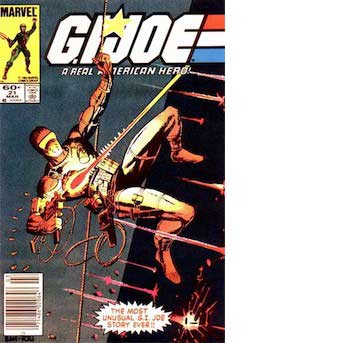Does This Cover Mean Anything to You?
For American mainstream comics fans born in the early ’70s, it seems that the answer is a resounding “yes!” This silent issue of G.I. Joe (a series my crowd dismissed as a forgettable toy tie-in comic) by Larry Hama was apparently an important moment in the young lives of future (male?) comics artists of the generation a decade after mine.
I think it was Larry Marder who first directed my attention to this weird phenomenon, but the wise and witty Shaenon Garrity has now penned the definitive write-up (with a cameo by Your Truly in the role of Mary Poppins).
I saw Shaenon and Andrew Farago last week before hopping my flight home from San Francisco, when I realized that my UX Week hotel was just three blocks from the Cartoon Art Museum where Andrew works.
Be sure to check out Shaenon’s own new book collecting the first run of her great new strip Skin Horse.
[thanks to Heidi for the heads-up]















Hey Scott,
I had to chuckle when I read this post of yours and subsequently went over to peruse Shaenon’s excellent run down on G.I.Joe #21. I’m in that exact same camp. I was born in the late 70’s, but became a huge G.I.Joe comic fan as a kid, tracking down back issues and poring over Larry Hama’s tightly wound stories.
“Silent Interlude”grabbed my attention like almost no comic before that point. Suddenly, pages of artwork that I would have usually read quickly became something to pore over and analyze in more depth. It focused my attention on the art and pacing of the story, even though I was only 8-9 years old at the time.
Hopefully more of us will come out of the woodwork with this post, heh.
Just got an email from Donald Leibold suggesting some additional reading on the subject.
I remember this issue (and most of the issues involving Storm Shadow and Snake Eyes dealing with the mystery of who killed the hard master!).
Even as a young child I could appreciate the level of storytelling that went into this “silent” comic.
rabid
Yes! I first got into comics when I was around 10 years old and it was through GI Joe and Transformers comics. Snake Eyes was my favorite Joe and so this issue had a big impact. 25 years later I can only remember a few stray panels from other issues but #21 was read so many times that it’s still fresh in my mind.
Panel to Panel checks in via Twitter to point to this recent interview they did with Hama, discussing the silent issue.
Scott, in answer to your tweeted question “Am I right that it was you who gave me the heads-up on this phenomenon?”
I can only rely on your memory,that it was, but one thing is for sure, I certainly was “Zelig/Forest Gumping” in the right place & time in the early ’90s to have come into contact the phenomenon first hand before most of the rest of our crowd did.
I recall strongly that the worldless GI JOE had been a strong influence on the nascent penciler kids at Extreme Studios. As you observed previously, us older indie folks pretty much dismissed the Marvel toy-tie in comics as inconsequential in our scheme of things.
But this book came up often in late night conversations with all the kids from all the Image Studios, Extreme, WildStorm, Top Cow.
Those “kids” are now middle-aged and many are at the peak of their powers and at the top of the economic comic book food chain.
Shaenon Garrity did a great job capturing the imporance of this book on a generation of cartoonists.
This issue was the first nail in the coffin of my obsession for Claremont-style comic writing. As a non-artist, it was a stunning eye-opener. It’s the only Joe issue I still have after all the purging.
Did this influence Frank Miller’s “Silent Night”?
Also,this comic sounds absurdly mythical,like the way we comic-junkies talk about the Watchmen comic.
The 9/11 of comics?Only Scott would’ve made such a time-warping statement.
Actually, Shaenon was paraphrasing. I’m not sure I said that exactly.
http://www.big.dk/projects/hav/hav.html
Comic presentation on Danish super-harbor.
That was very cool.
Toy tie-ins led to some of the best art of the 1980s. It’s a mistake to turn up one’s nose at them.
So I’ve learned. 🙂
On the point of toy tie-in comics: I’ve never really read GI Joe, but as I’ve said before, the Marvel Transformers comics were what got me into the medium. Fortunately they got me hooked on COMICS, and not hooked on Transformers specifically.
While i and my friends watched the various commercials broadcast every afternoon, I wasn’t a big fan of the licensed Marvel Comics.
If there is one comic that did make an impact from that time, it would be “The Kid Who Collects Spider-Man”. Marvel didn’t do much “third person” storytelling back then. (First person = title character, second person = supporting character, third person = one-time use. Null person = big event where characters are secondary to the plot.)
Later, Kurt Busiek would explore third person storytelling in Marvels and Astro City.
Also, while this issue of G.I.Joe was seminal, it was Virginia Romita who was the instigator. The issue was behind schedule, and Larry Hama and staff realized that if there was no dialog, a letterer is not needed, saving precious production time.
That said, any silent issue is a significant achievement. I know John Byrne did one during his Maverick days at Dark Horse. Are there others? (Marvel “Nuff Said”, but most fail as wordless comics. Space Dog by Hendrik Dorgathen.) What skills are needed to succeed with a silent story?
[…] Scott McCloud has a little bit more on the influence of the silent GI JOE issue, with some interesting comments that cast more light on the impact of this issue. We’ve often […]
The John Byrne silent story (Critical Error) was actually done before that, being first published in The Art of John Byrne.
He has also famously done a “blind” Alpha Flight issue, mostly without pictures but with panel borders and dialogue/captions. For good reason, this is much rarer than silent comics.
Getting back to them, France’s Lewis Trondheim is an habitual creator. NBM has translated quite a few of his silent books, like the L’il Santa series and the Mr. O/Mr. I dypthic.
Best,
Hunter (Pedro Bouça)
Well, it makes more sense to say that NBM PUBLISHED
Darn, the comment went while I was still writing.
I meant that NBM PUBLISHED quite a few of his silent comics, since there isn’t much, if any, to translate.
Best,
Hunter (Pedro Bouça)
I was always proud of this essay I wrote tying together the bathroom scene Sim’s Cerebus #77, Hama and Leialoha’s G.I. Joe #21 (silent issue), Krigstein’s Master Race, and Shaffer and Mitten’s Last Exit Before Toll all as influences on my comic Left On Mission.
http://blog.newsarama.com/2007/07/25/i-♥-sequential-art/
All before I took up the marketing mantle at BOOM! Fun stuff.
Chip
BOOM!
G.I. Joe? Never heard of it.
I think the conversation started out being about 9/11 and sort of segued into G.I. Joe. Like it does.
I borrowed my little brother’s copies of these and did actually go back and pick up my own, mainly of the Hama drawn or breakdown ones. That comic was pretty major all up and down the dial. People in ‘our’? scene definitely noticed that as well as the Dr. Deth with Kip and Muffy (title from memory here) comics that Hama did, and wished he drew or broke down more of them. There was another issue of GI Joe I remember that had 3 parallel storylines and there was a (I think wordless) sequence that Hama drew that really stood out. He had ridiculous visual storytelling chops.